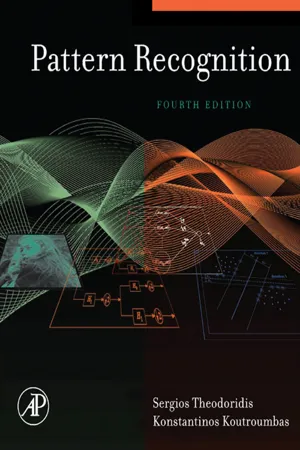
- 984 pages
- English
- ePUB (mobile friendly)
- Available on iOS & Android
Pattern Recognition
About this book
This book considers classical and current theory and practice, of supervised, unsupervised and semi-supervised pattern recognition, to build a complete background for professionals and students of engineering. The authors, leading experts in the field of pattern recognition, have provided an up-to-date, self-contained volume encapsulating this wide spectrum of information. The very latest methods are incorporated in this edition: semi-supervised learning, combining clustering algorithms, and relevance feedback. · Thoroughly developed to include many more worked examples to give greater understanding of the various methods and techniques· Many more diagrams included--now in two color--to provide greater insight through visual presentation· Matlab code of the most common methods are given at the end of each chapter.· More Matlab code is available, together with an accompanying manual, via this site · Latest hot topics included to further the reference value of the text including non-linear dimensionality reduction techniques, relevance feedback, semi-supervised learning, spectral clustering, combining clustering algorithms.· An accompanying book with Matlab code of the most common methods and algorithms in the book, together with a descriptive summary, and solved examples including real-life data sets in imaging, and audio recognition. The companion book will be available separately or at a special packaged price (ISBN: 9780123744869).- Thoroughly developed to include many more worked examples to give greater understanding of the various methods and techniques- Many more diagrams included--now in two color--to provide greater insight through visual presentation- Matlab code of the most common methods are given at the end of each chapter- An accompanying book with Matlab code of the most common methods and algorithms in the book, together with a descriptive summary and solved examples, and including real-life data sets in imaging and audio recognition. The companion book is available separately or at a special packaged price (Book ISBN: 9780123744869. Package ISBN: 9780123744913)- Latest hot topics included to further the reference value of the text including non-linear dimensionality reduction techniques, relevance feedback, semi-supervised learning, spectral clustering, combining clustering algorithms- Solutions manual, powerpoint slides, and additional resources are available to faculty using the text for their course. Register at www.textbooks.elsevier.com and search on "Theodoridis" to access resources for instructor
Frequently asked questions
- Essential is ideal for learners and professionals who enjoy exploring a wide range of subjects. Access the Essential Library with 800,000+ trusted titles and best-sellers across business, personal growth, and the humanities. Includes unlimited reading time and Standard Read Aloud voice.
- Complete: Perfect for advanced learners and researchers needing full, unrestricted access. Unlock 1.4M+ books across hundreds of subjects, including academic and specialized titles. The Complete Plan also includes advanced features like Premium Read Aloud and Research Assistant.
Please note we cannot support devices running on iOS 13 and Android 7 or earlier. Learn more about using the app.
Information
Table of contents
- Cover image
- Title page
- Table of Contents
- Copyright
- Preface
- Chapter 1: Introduction
- Chapter 2: Classifiers Based on Bayes Decision Theory
- Chapter 3: Linear Classifiers
- Chapter 4: Nonlinear Classifiers
- Chapter 5: Feature Selection
- Chapter 6: Feature Generation I: Data Transformation and Dimensionality Reduction
- Chapter 7: Feature Generation II
- Chapter 8: Template Matching
- Chapter 9: Context-Dependent Classification
- Chapter 10: Supervised Learning: The Epilogue
- Chapter 11: Clustering: Basic Concepts
- Chapter 12: Clustering Algorithms I: Sequential Algorithms
- Chapter 13: Clustering Algorithms II: Hierarchical Algorithms
- Chapter 14: Clustering Algorithms III: Schemes Based on Function Optimization
- Chapter 15: Clustering Algorithms IV
- Chapter 16: Cluster Validity
- Appendix A: Hints from Probability and Statistics
- Appendix B: Linear Algebra Basics
- Appendix C: Cost Function Optimization
- Appendix D: Basic Definitions from Linear Systems Theory
- Index